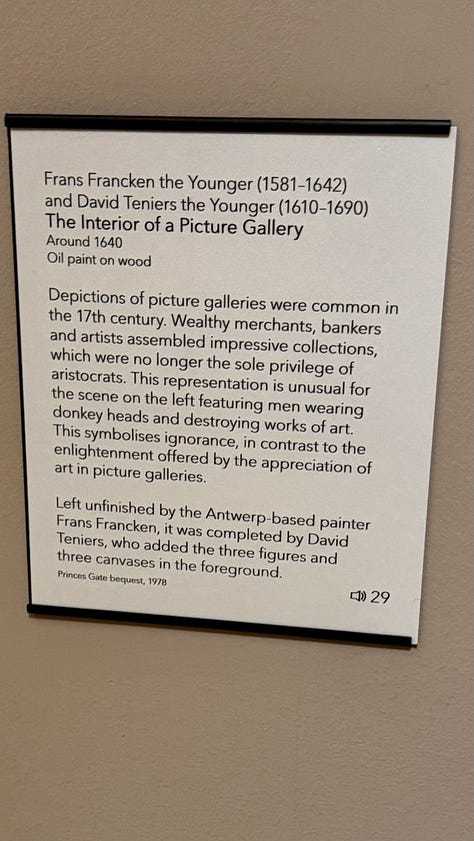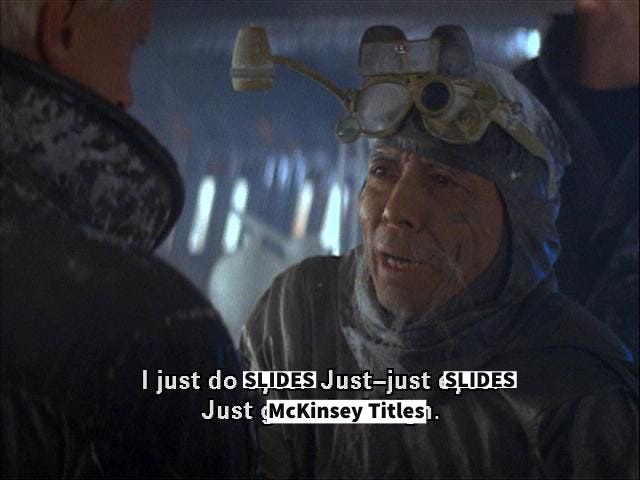Software is cheap
Also, links and fun finds from the World Wide Web. Plus, donkey-headed men destroy books.
And software is valuable
You want to maximize the amount of weird stuff you’re doing across the business to generate asymmetry with your competitors, with the admittedly serious caveat that the pathway to this particular ancient ruin is littered with skulls. Pay attention to the skulls. (From the HST or tech.)
Software costs very little to make, and you can rapidly try new things. As opposed to manufacturing or setting up a new Starbucks store. Experimenting costs little. This means that one of the business tools you get with software is discovering new competitive advantages. You can also just discover new ways to run your business better.
Now, you also need software to just do the job you’re already doing: the prescription refill app needs get me my pills. The mobile payment terminal needs to move €5 from my account to the barista’s account so I can get my coffee. You need predictability and reliability in software. It needs to be “boring” as we say every few years.
However, if you’re not also trying out new things, you’re not getting value from your software capabilities. Think of it in terms of money. If I put money in a checking account that gets zero percent interest, I am getting part of the utility of money - paying for things. But if I put some of my money in an index fund, I get the other utility of money: generating more money.
If you’re not using software to experiment with your business, you’re leaving money on the table.
How much experiment should you do? I dislike the reality of “it depends,” so I will give you a number: 10%. For every 9 applications that refill prescriptions or get me coffee, have one that’s just trying to stumble over new business ideas. Or, for existing software, you should spend a month experimenting.
And if that generates too many skulls, first look at the skulls and go down to 5%. Or up to 15%! You also need a disciplined, systematic way to do this experimenting so you’re not just messing around. If you don’t have a process like that, you up the chance of failure, and then you start to think software is risky, expensive, and something to dismiss.
Finding the right system is tricky, but luckily we have decades of practice and figuring it out in large organizations. Trust the process.
I cover just such a proven, enterprise-grade process in my book Monolithic Transformation. It’s got case studies and all that too. (And, I just noticed it’s now totally free - no handing over your email address required!)
Many organizations have neglected their software capabilities for years. What this means is that they have to opportunity to cheaply get better, so change how their business works and try to establish more moats (competitive advantage). It will probably take a year, and you’ll have some tooling catching up to do, but it’ll be worth it.
Relative to your interests
To Improve Your Mean Time to Recovery, Start at the Beginning - How to think about securing your cloud native apps, and apps in general.
Six technology myths and the Big Tech-lash - "So why do people think that it’s getting faster? Well, one of the reasons is they sort of conflate applications with platforms. So sure, ChatGPT gets 100 million people in a couple of months. But why is that? Well, they didn’t have to buy anything. I didn’t have to install anything. I could just go use it. And to me, that’s no different than saying that the Milton Berle show on TV went from no users to 50 million users in a year because all you had to do was turn on the station. And so the applications, whether it’s Facebook or Google or ChatGPT, it’s much easier to put an application on top of a radio program, a television or a computer or the internet than to buy a new platform.” And: “Data isn’t [the] new oil. I wish it were true. If only the world revolved around computers and data and information and connectivity and networks, life would be better. But the reality is that energy is still the main force in the global economy.”
Did a digital obsession ‘Just Do It’ in for Nike’s John Donahoe? - Getting direct versus channel (partners, “middlemen”) right is difficult. It’s especially risky when you dramatically change it (move from selling direct to selling through middle-people, or the other way around).
Oscar Health’s early observations on OpenAI o1-preview - Experiments with using AI in healthcare, specially the chain of reasoning stuff in o1-preview.
The impact of AI on the workforce: Tasks versus jobs? - “While many businesses use AI to replace worker tasks, there is little evidence that AI use is associated with a decline in firm employment.” // I’m starting to think that what’s going on here is that we haven’t found the right applications (uses of) for generative AI. Keep exploring!
Home Depot builds DIY GenAI model that tells human employees what to say - Better search/knowledge management: ‘Home Depot’s team built an LLM with RAG capabilities that answers queries by retrieving knowledge documents and processing them alongside data from previous chat history to “generate response suggestions for customer service agents.”’
Embracing AI To Augment, Not Replace, The Status Quo - Ideating AI apps: ‘1. Be on the lookout for processes that don’t scale well by adding more resources, are somehow constrained by human involvement, or could be improved if the human actor had more information. 2. Once you identify the process ask yourself either “How can I improve this process?” or “What do people hate most about this process?” 3. With that information, start to triage the type of AI that could help you. If you need more scale or more specific data, start with machine learning or vision apps. If you need more summarized data or connected information, start with generative AI.’
The Camera is the Filter - “Digital cameras are, themselves, a filter—each one reflects the technology and aesthetics of its time. A photo taken on an early 2000s digital camera, for instance, captures not only the subject but also the era’s unique imperfections—grainy textures, soft focus, lower resolutions, and muted colors. These qualities are part of the photo’s authenticity, a snapshot of history shaped by the camera’s limitations. Adding filters that emulate an old type of film erases that context, replacing the original look with a trendy (at the time), artificial aesthetic that distorts the photograph’s integrity. To me, that defied what I thought the purpose of the job was, which was to document these factories in that particular moment in time.”
At last, women of Paris can wear the trousers (legally) after 200-year-old law is declared null and void - “Since 7 November 1800, it has been technically illegal for a woman to wear trousers in Paris without a police permit. Just over a century ago, exceptions were introduced for women riding horses or bicycles.”



Wastebook
“Do not fall into the trap of anthropomorphizing Larry Ellison. You need to think of Larry Ellison the way you think of a lawnmower. You don’t anthropomorphize your lawnmower, the lawnmower just mows the lawn - you stick your hand in there and it’ll chop it off, the end. You don’t think ‘oh, the lawnmower hates me’ – lawnmower doesn’t give a shit about you, lawnmower can’t hate you. Don’t anthropomorphize the lawnmower. Don’t fall into that trap about Oracle.” – Bryan Cantrill, via.
“Success teaches nothing.” Here.
“Appreciative condescension.” Here.
Also: “an invitation to condemnation.”




Conferences
Talks I’m giving, places I’ll be, and other plans.
Cloud Foundry Day EU, Karlsruhe, Oct 9th. VMware Explore Barcelona, speaking, Nov 4th to 7th. GoTech World, speaking, Bucharest, Nov 12th and 13th. SREday Amsterdam, speaking, Nov 21st, 2024.
Discounts! SREDay Amsterdam: 20% off with the code SRE20DAY. Cloud Foundry Day 20% off with the code CFEU24VMW20.
Logoff
While I was in London last week, I checked out The Courtauld. Above are two fun things from it. There’s two Brueghels in there, and I always want to see those in person. They’ve got an impressive virtual tour that you should check out if you like museums.


